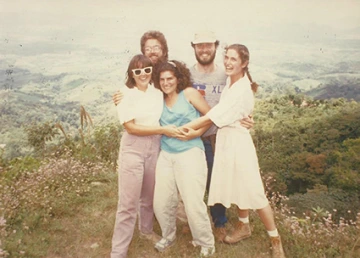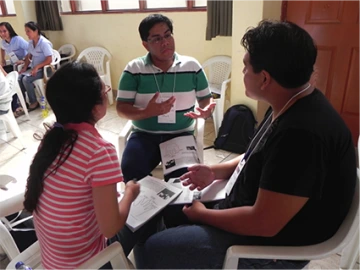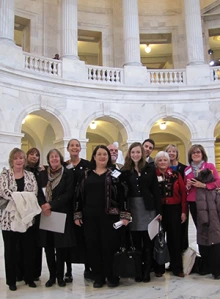Finding Peace Amid Violence
As 2015 draws to a close, we continue to face a level of violence in the United States that is challenging, heartbreaking and deeply disturbing.

As 2015 draws to a close, we continue to face a level of violence in the United States that is challenging, heartbreaking and deeply disturbing. Having personally faced violence on multiple levels, I want to share what I have learned from the people who have both suffered and persevered the most.
My journey toward becoming a nurse practitioner and faculty member at the University of Arizona College of Nursing began in Nicaragua during the Contra War when I was a human rights worker. In the late 1980s, I worked with a small non-profit organization called Witness for Peace, which, for the first time ever, sent U.S. citizens into a war zone to document human rights abuses against civilians. On my first night in the "campo,” or countryside, the “contras” (counter-revolutionary forces) attacked the village where I was stationed and killed an elderly man.
That was the first time I had been exposed to extreme violence. During the next nine months, I documented attacks against civilians, accompanied health-care workers who continued serving despite death threats and led delegations of citizens into the war zone. As powerful as the memories of that violence are, my life was more transformed by the love that the Nicaraguan people offered to me and to each other. Most memorable was the mother who took in the contra fighter that had killed her son when he returned to their village after leaving the contra forces. When asked why—and how—she could do such a thing, she simply responded, “He has nowhere else to go.” This was one of the most profound lessons I have ever learned: we must live and love as if we, too, have nowhere else to go.

Witness for Peace team members in Jinotega, Nicaragua, near the Honduran border, 1988.
It is one thing to go into a war zone knowing violence awaits you. It is a completely different thing to walk into a classroom on a beautiful, crisp fall morning—Oct. 28, 2002—and be faced with the unthinkable. That day, I witnessed a fellow student fatally shoot two of my professors and learned that a third had been killed in her office. Yet it is not their deaths, but the way they each fully and richly lived their lives that persists over time. When I walk into work each day, I feel an overwhelmingly positive energy: a deep desire to become nurses on the part of the students, a commitment to excellence on the part of the staff and administration, and an abiding love of teaching and learning on the part of the faculty. I have been healed in so many ways by coming back to this building and by finding my life so greatly enriched by teaching. In the 13 years since the shooting, I have tried in my own way to honor the lives of the professors who were killed by seeking healing from trauma for myself and for others, and by working to prevent gun violence here in the United States.
Shortly after the tragedy in 2002, I discovered a non-profit organization called Capacitar International, which provides training in trauma-healing techniques across the globe. For more than 25 years, Capacitar has gone to the places of the worst violence imaginable—from Rwanda to El Salvador, from South Africa to Northern Ireland—teaching community members hands-on techniques that help resolve the profound consequences of abuse, violence and trauma. Backed by evidence-based research, this type of intervention is critically important globally, as most of the world’s population lacks access to professional mental health services.

Residents of Lima, Peru participate in a Capacitar workshop to help heal trauma in March 2014.
In the spring of 2014, I traveled with a Rotary International service group to Lima, Peru, to provide Capacitar trainings in five of the poorest neighborhoods, where 90 percent of the people had experienced—and were experiencing—trauma from the recent, prolonged war and the massive influx of people fleeing the countryside to escape the violence. Again, violence knows no boundaries, including the boundary of time, as many of the women were victims of domestic violence with partners who themselves had experienced violence during the war.
The trip to Lima was an incredible gift and reminded me of my time in Nicaragua. In less than a week we presented five day-long workshops, with 40-60 people in attendance each day. There was the reality of a grueling schedule; long, difficult drives across the entire city; and the challenge of working and teaching in my second language. But waiting for us each day were people eager to learn, grateful for a day of rest and renewal and appreciative of techniques to heal their families and neighborhoods. My favorite moment was when the security guards at one site, who had been watching us from a distance, drew closer to our circle and then joined in the activities as the day progressed. This is my favorite lesson about peace: we all have an astonishing capacity for goodness, even in the face of extreme violence. I hope I have the opportunity to witness that truth over and over again throughout my life.

Lisa Kiser and other survivors of gun violence on Capitol Hill in February 2013 following the Sandy Hook shootings.
When I face the news each day, I am greatly strengthened by what I have learned from the people at the College of Nursing, in Nicaragua and Peru, and in other parts of the United States. I am a witness to their efforts to bring peace to this world, and my last words are these: together, we will succeed.
About the Author
Lisa Kiser, MSN, BSN, CNM, WHNP, is a clinical instructor at the University of Arizona College of Nursing, where she earned her undergraduate degree in nursing. A certified nurse midwife and women's health nurse practitioner, she earned her graduate degree from Frontier University in Kentucky. She has been trained in integrative healing techniques for the treatment of stress and trauma, as well as for labor (birth) support, and worked as a doula, labor and delivery nurse and nurse-midwife, serving diverse communities in Tucson. In her free time, Lisa loves to bake pies, go on long runs and volunteer in the community

